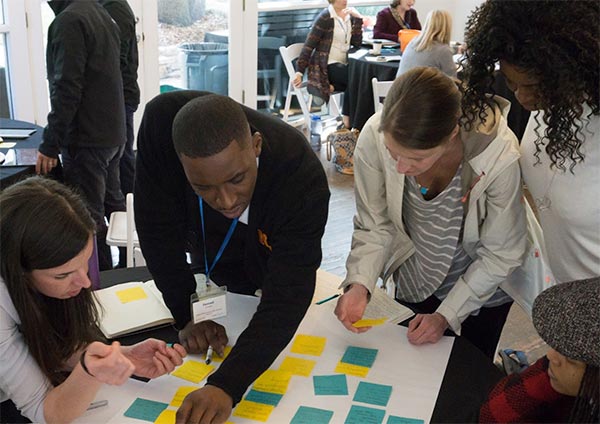Surveys and conversations over the past year have revealed that many of our partners and community overall are struggling with their financial state and are particularly worried about the end of federal relief funds. This pain point is acutely felt by those in Transcend’s Model Sharing Community, a community of schools and other entities that have innovative learning models to share. Our most recent community survey showed that this group of partners was concerned with economic challenges, such as financial sustainability, philanthropy, pricing, finding new partners, and generating demand for their innovative model, among other related topics.
In the summer of 2024, Transcend embarked on a project to learn directly from model sharers and folks who have a view into the field of model sharing in order to better support our community with financial sustainability strategies. We dug into our partner and community sentiments to understand how they define financial sustainability and to clarify their financial structures and associated challenges and pain points.
We then spent time learning from experts exploring questions such as:
- Is there a path to share models in a way that is financially sustainable and what is the role of philanthropy?
- What solutions and strategies might model sharers try?
- Which model sharers demonstrate relatively high levels of both financial sustainability and impact, and how did they get there?
Financial Sustainability
So what exactly is this elusive “financial sustainability” that we are striving toward? The model sharers we interviewed define it as:
- Revenue diversification in order to reduce their reliance on philanthropic funds
- Ability to invest more resources into innovative solutions or initiatives as opposed to just “keeping the lights on”
- Financial capacity and capabilities within their own organizations.
We also learned that a there are a number of factors outside of a model sharer’s control that can impede their path toward greater financial sustainability:
- Inflation and other macroeconomic conditions, including an increase in salaries and other related costs;
- High levels of leadership turnover in schools/districts, unpredictable shifts philanthropy, federal funding, and district demand;
- Lack of reliable information about the market (eg, some believe the market is saturated with intense competition and other says there aren’t enough model sharers; we also different perspectives about the availability of philanthropy and other funding sources)
four Key Themes from Our Research
Transcend completed research using publicly available data (e.g., model sharer websites, public statements, philanthropic reports), interviewed individuals working for 10 diverse model sharers, and collaborated with five experts from the field who have insights on this topic. Our research showed that there are four key themes impacting model sharers:
- Reliance on costly in-person training
- Reliance on philanthropy
- Reliance on limited internal financial capacity
- Challenges with identifying and engaging partners/clients
Theme #1: Reliance on costly in-person trainings
Many model sharers, especially those that have more “innovative” or robust models, provide a bundle of resources, tools, and services to support adopting communities to support successful implementation. But this level of intensive support is costly. It often requires the model sharer to significantly invest in new roles and related internal training as well as an increase in direct expenses such as travel and resource creation. As a sector, model sharers are interested in understanding how costs can be reduced while maintaining fidelity and quality of implementation.
Theme #2: Reliance on philanthropy
Philanthropy continues to play a critical role in helping model sharers to overcome the financial and operational hurdles they face. While the model sharing market is complex, most experts agreed that there is a path—albeit a challenging one—for school-based innovators to share their models in ways that are financially sustainable and can over time become less or non-reliant on philanthropy. The small number of funders we talked to for this research were most excited about model sharers that are:
- Focused on high-demand, relevant topics (e.g.,high-quality instructional curriculum, professional learning, high dosage virtual tutoring, college access, diagnostic assessments, & math innovation)
- Clear about their market, audience, and testing product-market fit
- Nationally-driven, but locally designed and implemented
- School operators who were able demonstrate a learning feedback loop with their “spread arm”
- Able to clearly explain their “why” and the outcomes of their models as opposed to the “how”
- Interested in micro-grants (e.g., $5,000 for a mini pilot; $40,000 for implementation)
It’s worth noting that philanthropic interest fluctuates over time. This unpredictability poses a threat to financial sustainability, which is one reason model sharers are trying to pivot to diversified revenue sources with strong earned revenue opportunities.
Theme #3: Reliance on limited internal financial capacity
Many model sharers discussed having done significant work to reduce costs and that they are already operating with fairly lean and nimble staffing structures. Lean and nimble staffing means they are managing these revenue streams and cost drivers while having limited internal systems and dedicated staff that can work on pricing, marketing, and revenue-generation strategies. In addition, many of these organizations were started by educators who may not have much background or expertise in many of the skill sets that are now critical, like marketing, sales, or business planning. This leads to a cycle where the lack of resources constrain their financial strategies and vice versa. Often, model sharers report that their programs are more mature than their operations and systems.
Theme #4: Challenges with identifying and engaging partners/clients
Several model sharers reported that they are struggling to ensure that their offerings “meet the market” and/or are having difficulty identifying potential adopters. There seem to be many variables at play here including the post-pandemic priorities around learning loss and teacher retention, the politicization of social-emotional learning, the challenge to clearly demonstrate impact, and the winding down of ESSER funds. Newer entrants to model sharing can often find an eager group of early adopters but have challenges translating that interest into an ongoing and robust pipeline of additional adopters.
Three Recommendations for Overcoming Challenges
Successful model sharing organizations and the experts we met with recommend that model sharers be customer-centric, evidence-focused, and test different internal structures and solutions to navigate a challenging landscape.
Recommendation #1: Start Small
One option is to start small, focusing on an ‘unbundled’ set of solutions that solves a specific pain point in the system. The benefit of this approach is that it can help serve as a “landing” or entry point that can open the way to additional opportunities. However, if not careful, this may reinforce industrial era learning, compromise the original vision of the model, and result in little impact. To get started, model sharers could find ways to quickly test the market through mini pilots, preventing the build up of resource-intensive programs before knowing potential demand.
Recommendation #2: Align with School Budgets and Funding
The next recommendation from experts and more established model sharers is to spend time working with schools/districts to align programming and models to specific budget lines (e.g., professional development, instructional materials) or funding sources (e.g., Title 1). This approach mitigates competing with discretionary funds and provides buyers with a clearer understanding of how to pay. Unfortunately, it can often be resource intensive, especially because it can vary significantly (e.g., state by state). To get started, consider starting small by selecting a few districts or geographic areas to focus on.
Recommendation #3: Demonstrate Impact and Efficacy
Funders and buyers are not only looking for the “how” of the model, but also the “why” and the results (i.e., student outcomes). The challenge is that finding evidence of outcomes is often a lengthy and resource-intensive process. Despite these challenges, experts suggest that model sharers partner with a third-party organization that can support your impact evaluation strategies and help you build a compelling and credible evidence base.
These are just a few starting point recommendations, and we recognize these challenges can be tricky to navigate on your own. So that’s why, over the next year, Transcend is looking to provide a variety of learning experiences, community conversations, and tools, all focused on financial sustainability. For example, we worked with our friends at NorthStar to document the top financial sustainability shifts for model sharers. And based on your feedback, we are working to build out more guidance and tools related to the shift toward a mission-aligned investment in earned revenue. Stay tuned!




